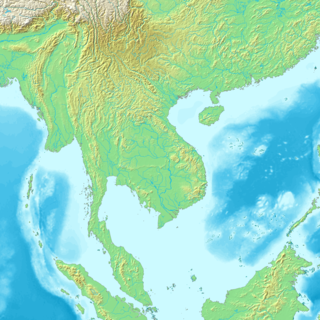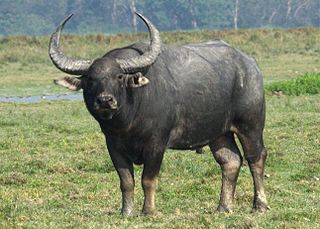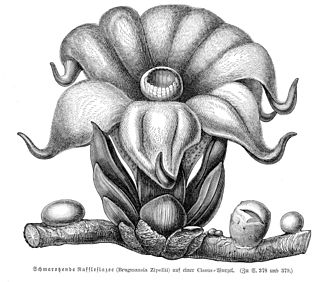
Mainland Southeast Asia is the continental portion of Southeast Asia. It lies east of the Indian subcontinent and south of Mainland China and is bordered by the Indian Ocean to the west and the Pacific Ocean to the east. It includes the countries of Cambodia, Laos, Myanmar, Thailand, Vietnam, and Peninsular Malaysia.

The post-Angkor period of Cambodia, also called the Middle Period, refers to the historical era from the early 15th century to 1863, the beginning of the French protectorate of Cambodia. As reliable sources are very rare, a defensible and conclusive explanation that relates to concrete events that manifest the decline of the Khmer Empire, recognised unanimously by the scientific community, has so far not been produced. However, most modern historians have approached a consensus in which several distinct and gradual changes of religious, dynastic, administrative and military nature, environmental problems and ecological imbalance coincided with shifts of power in Indochina and must all be taken into account to make an interpretation. In recent years scholars' focus has shifted increasingly towards human–environment interactions and the ecological consequences, including natural disasters, such as flooding and droughts.

Ram Khamhaeng or Pho Khun Ram Khamhaeng Maharat, also spelled Ramkhamhaeng, was the third king of the Phra Ruang Dynasty, ruling the Sukhothai Kingdom from 1279 to 1298, during its most prosperous era.

Romvong, Lamvong or Ramwong, Rambung, Vietnamese: lăm-vông) is a type of Southeast Asian dance where both females and males dance in a circle. It is a popular folk-dance in Xishuangbanna (China), Cambodia, Laos, Malaysia and Thailand. It is a slow round dance continuously moving in a circular manner, and incorporates graceful hand movements and simple footwork. Both men and women participate in the same circle.
Trigonostemon is a plant genus of the family Euphorbiaceae and the sole member of its tribe (Trigonostemoneae). It was first described as a genus in 1826. It is native to Southeast Asia, southern China, the Indian Subcontinent, Queensland, and a few islands in the western Pacific.
Cnesmone is a genus of plant of the family Euphorbiaceae first described as a genus in 1826. It is native to southern China and to much of Southeast Asia.

Dance in Thailand is the main dramatic art form in Thailand. Thai dance can be divided into two major categories, high art and low art.
Ram Chet Chaudhary is an Indian agricultural scientist.

The wild water buffalo, also called Asian buffalo, Asiatic buffalo and wild buffalo, is a large bovine native to the Indian subcontinent and Southeast Asia. It has been listed as Endangered in the IUCN Red List since 1986, as the remaining population totals less than 4,000. A population decline of at least 50% over the last three generations is projected to continue. The global population has been estimated at 3,400 individuals, of which 3,100 (91%) live in India, mostly in Assam. The wild water buffalo is the most likely ancestor of the domestic water buffalo.

The thon and rammana are hand drums played as a pair in Thai classical music. It consists of two drums: the thon (โทน), a goblet drum with a ceramic or wooden body and the rammana (รำมะนา), a small rebana-typed frame drum or tambourine. They are used usually in the khruang sai ensemble. The thon gives a low pitch and the rammana gives a high pitch. Earlier in the 20th century, the thon and rammana were sometimes played separately.

Sapria himalayana, commonly known as the hermit's spittoon, is a rare holoparasitic flowering plant related to Rafflesia found in the Eastern Himalayas. Sapria himalayana represents the extreme manifestation of the parasitic mode, being completely dependent on its host plant for water, nutrients and products of photosynthesis which it sucks through a specialised root system called haustoria. These haustoria are attached to both the xylem and the phloem of the host plant.

Rhizanthes is a genus of four species of parasitic flowering plants in the family Rafflesiaceae. They are without leaves, stems, roots, or photosynthetic tissue, and grow within the roots of a few species of Tetrastigma vines. The genus is limited to the tropical forests of Southeast Asia. The flowers of Rhizanthes are very large, they vary from 14 to 43 cm in diameter. At least one species of Rhizanthes, Rh. lowii, is endothermic.
Rhizanthes deceptor is a species of parasitic flowering plant without leaves, stems, roots, or photosynthetic tissue. They grow on roots of the Tetrastigma vine. They are only found in the tropical forests of Sumatra at 500–700 m. The flowers are white, with red-brown tips, and are from 20 to 27 cm across.
Rhizanthes infanticida is a species of parasitic flowering plants without leaves, stems, roots, or photosynthetic tissue. They grow on roots of the Tetrastigma vine. They are found in the tropical forests of southern Thailand, western Malaysia, and Sumatra. The brown flowers are from 14 to 22 cm across. The flowers smell like a mammalian carcass and attract flies, which pollinate the blooms while laying their eggs inside. The flies' larvae die due to the lack of nutrients, hence the species name "infanticida".
Rhizanthes zippelii is a species of parasitic flowering plant without leaves, stems, roots, or photosynthetic tissue. Its flowers bud out of the roots of the Tetrastigma vine. It is found in the tropical rainforests of Java. The flowers are reddish-brown, with long hanging tips, and are from 12 to 29 cm across.
The Cambodian–Spanish War (1593-1597) was an attempt to conquer Cambodia on behalf of King Satha I and Christianize Cambodia's population by the Spanish and Portuguese Empires. Along with the Spanish, Spanish Filipinos, native Filipinos, Mexican recruits, and Japanese mercenaries participated in the invasion of Cambodia.
Chey Chettha I was a king of Cambodia who ruled from 1584 to 1595.
Preah Ram I, also known as Reamea Chung Prey, was the Cambodian king ruled from 1594 to 1596.
Pitardella is a genus of flowering plants belonging to the family Rubiaceae.

Sapria ram is a holoparasitic flowering plant endemic to Thailand. It is found in central and southern Thailand. H. Bänziger & B. Hansen (1997) consider specimens in Thailand formerly identified as Sapria poilanei to be Sapria ram.











